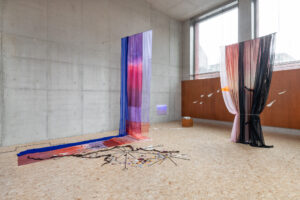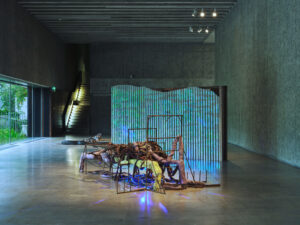2 Sep 2025
News
After Hours: Clíodhna Timoney on Landscape, Bodies, and Collective Potential

Clíodhna Timoney, Installation shot of body of work In the Wee Hours, The 40th EVA International Biennial, Limerick, 2023. Photograph: Jed Niezgoda
Clíodhna Timoney’s multifaceted practice explores the unstable relationships between humans, the nonhuman, and the landscape. In her work, the Ireland-based artist, originally from County Donegal, moves along murky edges and crepuscular margins, creating piercings through which movement across specific times, spaces, and groups can shape and shift, gathering and releasing the potential for collective action.
Timoney was a resident in HIAP Suomenlinna in the late spring-early summer of 2025 via the Dublin Temple Bar Gallery + Studios / HIAP international artist exchange. I got the opportunity to talk with Timoney about her work and the time she spent on Suomenlinna island.
In this text, I approach Timoney’s practice through four exhibitions spanning from 2020 to 2023. In these works, she engages with specific, seemingly enclosed spaces such as a dance hall, a farmyard, and cars. They function as transitional portals where the boundaries of our bodies—psychological and political—are porous, continually shifting and being renegotiated.
Timoney’s practice resonates with Baroque Sunbursts, Mark Fisher’s text on rave politics, which explores how raves, fairs, clubs, and other celebrations generate a temporality distinct from everyday life. They gather energy that can mobilise people and destabilise dominant systems, such as the all-consuming logic of capitalism.
In the Wee Hours
In her installation In the Wee Hours (a Platform Commission included in the The 40th EVA International Biennial, Limerick, 2023), Timoney explored the spatial embodiment of the so-called “Showband Era” of Ireland—a cultural movement inspired heavily by multiple genres such as rock ‘n’ roll as well as country and western that peaked in Ireland during the 1960s and 1970s—through its central site: the dance hall.
Timoney approached the dance hall as a liminal space, a gathering point for bodies and nighttime energies. Primarily built in rural areas, these halls offered young people a much-needed entry point into a dreamscape beyond the routines of labour and the harshness of social norms. This borderland experience could be literal: Timoney’s father once worked at a dance hall called Borderland in Muff, situated on the border between the Republic of Ireland and Northern Ireland (today it is an outlet store). For Timoney, this dance hall culture is deeply tied to Ireland’s rural experience, with movements and gestures that carry a certain specificity.
Materially, this liminal potential was manifested in the form of textiles, ceramics, found objects, and video. The textiles referenced staging, performance, and clothing; materials that are malleable and mobile, yet also transparent. The video work presented a dreamscape of textile, landscape, and disco ball, while on the floor lay scatterings of mirror and steel, a reference to the gliding tones of steel guitars, echoing the country-influenced sounds of the scene. On the walls hung hand-made ceramic tears titled Spit on Me, evoking both the damp landscape of the Northwest of Ireland and the charged atmosphere of the dance floor: bands aimed to “Send ‘em Home Sweating,” and girls in the crowd would famously scream, “Spit on me, Dickie,” at a well-known bandleader.
However, for Timoney, the most significant aspect of the dance hall experience was the journey itself; the movement through nocturnal landscapes as people traveled long distances in search of connection to other bodies and spaces, filled with that magical energy that the permeable-opaque light of dusk and dawn creates. The title In the Wee Hours reflects the transformative potential of shifting light, when people, categories, and structures become fluid and are in motion.

Clíodhna Timoney, Installation shot of body of work Flashes of Light VISUAL, Carlow, 2022. Photograph: Ros Kavanagh
Flashes of Light
In her earlier exhibition Flashes of Light (2022) at Link Gallery, Carlow, Timoney worked with the materialities of her family’s farm and its collage of traces, histories, and varied temporalities. Although the farm is no longer functional, remnants of its past activities remain present. The tightly enclosed farmland prompted Timoney to question how societies arrived at a point where land is so rigidly zoned, enclosed, and controlled while public spaces for gathering, such as nightclubs, are becoming increasingly rare.
Following Timothy Morton’s concept of nature as something that has become toxic, Timoney constructed a landscape that explores the potential of the farm and its entangled material and temporal dynamics, but not solely through “natural” materials. The sculptural work titled The Mesh combined corrugated metal, iridescent foil which responded to natural light, with salvaged materials from the farm, plywood, LED lights, organic matter, and a horseshoe cast from a bag of discarded cans. Sculptural works such as Worn Out Dancers and How Mutable Are Our Feelings represented entanglements of bodies and tyres, textiles, and soil, emphasising the porous boundaries between human, material, and spatial environments.
Flashes of Light examines the potential of space through the lens of fictioning. It draws on elements of early rave culture, which often involved reclaiming rural spaces and creating new relationships to a place.In an era when neoliberal forces increasingly restrict the ability to gather and protest, Timoney considers possible outlets that can disrupt temporalities and social structures, continuing beyond dawn into a new day.
AE86-II & AE86
Timoney’s work also engages with elements of violence present in collective liminal experiences and the kinds of spatial practices they can generate. In her works AE86-II (2021) and AE86 (2020), she examines a specific Irish car culture known as “diffin,” where drivers take to back roads and crossroads, often under the cover of darkness, to meet others and engage in performative driving. In many cultures, crossroads carry deep symbolic weight, functioning as portals or points of connection to other worlds.
Diffing contains both violent and collective dimensions through its border-dissolving nature. Like dance halls, outdoor raves, and clubs, it holds the potential to alter behavior, opening up space for performance and spectacle. It possesses a certain glamour—offering the simultaneous possibility of being seen and becoming invisible—often enhanced by the conditions of light and darkness. The speed, rhythm, and looping motion of diffing stand in contrast to the linearity and control of neoliberal structures: its gestures, marks, and temporal loops challenge straightforward narratives of progress.
At the same time, the toxic undercurrent of petro-culture is ever-present in the work. This is evident in both the point-of-view video pieces and the techno-human sculptural forms made from salvaged car parts and soil. The phrase associated with diffing, “Keep ‘er lit,” becomes a layered emblem—evoking the unchecked consumption of fossil fuels as well as more ambiguous innuendos. Timoney’s works materialize the murkiness of excitement, speed, violence, and intimacy: the human desire for intensity, which can ultimately turn destructive toward the self, others, non-humans, and the land itself.
Future potentials
In her earlier works, Timoney engaged with the rural geographies of the Donegal area, exploring their layered histories of colonialism and capitalism. She found the HIAP Suomenlinna residency liberating, as it helped her recognise that all sites, practices, materials or bodies both human and nonhuman contain their own microhistories that connect to larger narratives. The residency opened up new possibilities for collaboration in diverse settings.
During her residency on Suomenlinna over the sun-filled days of the early summer, Timoney continued thinking about lightness and darkness, lunar and animal cycles, all while challenging the idea of binaries by looking into the potentialities of the intangibility of dusk and dawn. She experimented with photography, a medium alluding to memory and visualisation. At the end of the three-month stay she realised that the interest in photographic tools was really about leakages: not about capturing an image, but working with light while using the camera as a tool for navigating. Rather than seeking definitive answers, she continues to search for new lenses through which to perceive the world.
*********
Clíodhna Timoney (she/her) is a visual artist based in Ireland. Rhythm has been a constant concern in her practice; working across imagery, sculpture, and sound, she explores rhythm’s capacity to connect, ignite, and fundamentally destabilize fixed states and absolutes.Timoney was awarded the Temple Bar and Gallery + Studios/HIAP International Residency Exchange in 2025.
Riikka Thitz (she/her) is a Helsinki-based curator working at the intersection of performing and visual arts. Grounded in site-responsive approaches, her practice emphasizes bodily experience, multisensory engagement, and the materiality of art. In 2023–24, she was a curator-in-residence at HIAP Suomenlinna.
